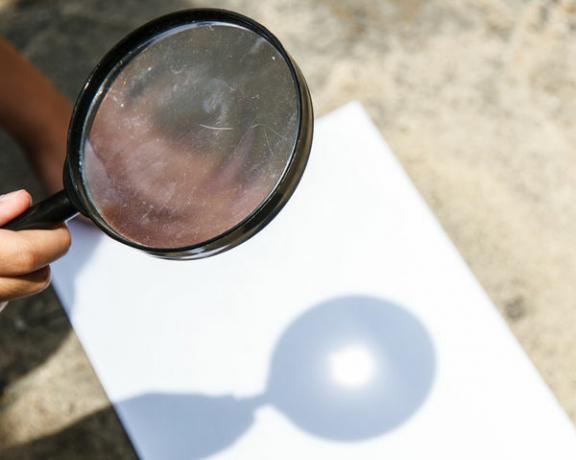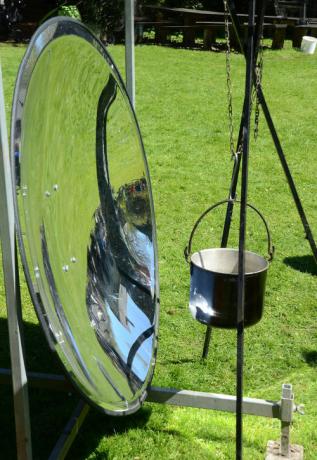Images virtual and real are two categories of images formed by optical systems, such as lenses or mirrors. When light interacts with these optical devices, it can converge, crossing some point after it has been reflected or refracted, or it may diverge, spreading in other directions.
Lookalso: Defining an Optical System
real images
we call real image every image produced by a beam of light that converge about some point after have been refracted for one lens convex (thin edged) or after it has been reflected by a mirror, as in mirrors sphericalconcave or parabolic.
Therefore, all real images are formed by the crossing of light rays. Thus, this type of image can be designed over some bulkhead, like a white wall. So, in practice, a lensconvex, like a magnifying glass, it is able to project an image of the Sun with ease. Look at the figure below:

In the image above, the point of light on the sheet of paper is nothing more than a real image of the Sun projected onto a white screen.
Due to the crossing of light rays,
all real images are inverted, that is, the real image of an object facing up will be face down.
Observe the figure above, in it we can see a concave mirror used for to concentrate rays of sunlight into a pot in order to heat it. If you look closely at the image formed in this mirror, you will see that it is upside down, i.e, invertedin relation to the setting. Therefore, a real image.
virtual image
virtual images are those produced by some optical system capable of “scattering” light rays in opposite directions, “distancing” them from each other. It is common that concave lenses (with thick edges), flat or convex mirrors and even concave mirrors (in special cases) combine this type of image.
Lookalso: The convex mirror and the supermarket
Differently of the real images, in the virtual images there is no crossing of the rays of light, but of its extensions. This crossing takes place inside the mirrors or behind the lenses. Furthermore, all virtual images present the same orientation that its objects, unlike real images, are inverted. know more about crossingFrom extensions of light rays by clicking on here.
Virtual images also provoke us to sensation to be produced in the background From mirrors or from lenses. Have you ever noticed that when looking at a mirrorflat, your reflection is not on its surface, but yes at the same distance where do you find yourself from the mirror? Look at the picture:

In the image above, we have an example of a virtual image formed by a plane mirror. An object approaching a car's rearview mirror will be closer than it appears to be.
Despite the mirrors concavebe able to combine real images, as exemplified above, they can also be used to produce virtual images, as in cases where the objects are very nextto its surface. A clear example of this is in the mirrors used by dental surgeons: those small mirrors, despite being concave, produce virtual images:

In the picture below, we have a mirror convex combining a Imagevirtual. Realize that this image is right, that is, presents the same orientation of its object:

Another characteristic common to all virtual images is the fact that they cannot be projected, that is, they cannot be formed on any surface other than the mirror.
Lookalso: light reflection
Summary table
We can gather the information presented above in this summary table:
By Rafael Hellerbrock
Graduated in Physics
Source: Brazil School - https://brasilescola.uol.com.br/fisica/diferencas-entre-imagens-reais-virtuais.htm
